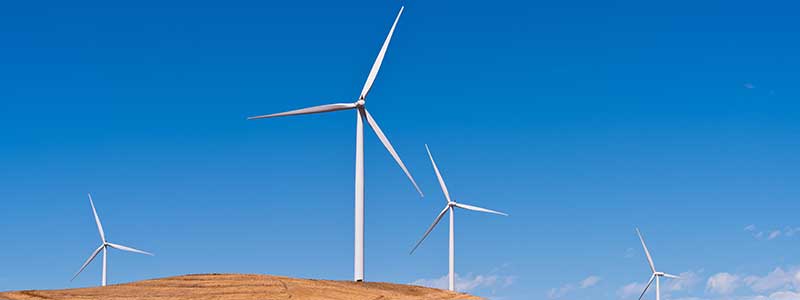Harnessing the Power of the Wind to Create Electricity
 It is only within the last 20 years or so that the conversion of wind power into a renewable source of energy has become a viable option.
It is only within the last 20 years or so that the conversion of wind power into a renewable source of energy has become a viable option.
Modern wind turbines harness the power of the wind by using rotors fitted with aerodynamic blades to turn a shaft which rotates inside the generator which will then produce green electricity.
The use of wind farms (banks of turbines) is now a global phenomenon and is one of the fastest growing means of green electricity generation. Europe is the largest producer of wind powered electricity production with 72% of all power generated globally. The use of wind farms quadrupled during the late 90’s to early 00’s, but only 0.4% of the total electricity generated on a global scale can be attributed to wind power.
The UK has the ideal meteorological make up to harness wind power technology. Indeed, we have 40% of Europe’s total wind energy resources, but the resource is severely underused as we only produce 0.5% of our electricity requirements through this method. One could argue that this is due to the ongoing controversy that surrounds this form of renewable energy (see pros vs. cons section below).
When siting a wind turbine, it is important to house it as high as possible because wind speed increases with height, and in an area that has a clear exposure free of obstructions such as housing or trees.
It would be advisable to contact your local meteorological office to ascertain the wind levels in your local area before undertaking any work.
Many small wind turbines produce direct current (DC) electricity which will require an inverter to convert the DC electricity to alternating current (AC) electricity. When there are low wind speeds it is advisable to have a back up diesel generator. Alternatively, systems can be grid-connected (this would remove the need for any battery storage), however, a special converter and controller to convert the energy from DC to AC will be required so that the electricicty is produced at a standard that is acceptable to national grid requirements.
Typical sizes of domestic wind turbines are 0.6kW to 8kW with a starting wind speed of approximately 2.5-4m/s and an optimum wind speed rating of approximately 10-12m/s. The costs for domestic installation can range from £5,000 to £20,000 for all equipment and installation (dependent on size and specifications). If a small scale 6kW wind system was required (providing approximately 12,000 – 15,000 kWh of electricity) the cost would be roughly £200 – £500. This small wind turbine system would be ideal for battery charging applications as found on caravans for instance.
Pros vs. Cons
The use of wind turbines for the generation of green electricity is often an emotive subject and there are persuasive arguments for and against the proliferation of this form of renewable energy generation.
For Wind Power
Land-based wind energy has the potential of covering six times the world’s electricity consumption, or one time the world’s total energy consumption.
The energy consumption for production, installation, operation and decommission of a wind turbine is usually earned back within 3 months of operation.
After decommissioning wind turbines, even the foundations are removed.
Conventional and nuclear plants also have sudden unpredictable outages. Statistical analysis shows that 1000 MW of wind power can replace 300 MW of conventional power.
More recent wind farms have their turbines spaced further apart, due to the higher capacity of the individual wind turbines. They no longer have the cluttered look of the early wind farms.
It is possible to hold a conversation directly underneath a modern wind turbine without any difficulty whatever and without raising one’s voice. The modern turbine is quieter than its predecessors owing to improvements in the blade design.
Studies show that the number of birds and bats killed by wind turbines is negligible when compared with other human activities such as traffic, hunting, power lines and high-rise buildings.
Against Wind Power
There is a perception that wind farms are noisy and are eyesores.
The large number of turbines required for a viable wind farm, and the huge number of wind farms required to meet the ambitious goals of the wind energy industry and governments, ensures that more people will be affected by them.
The construction of a large wind energy facility is also far from ecologically benign in previously undeveloped locations. It requires wide straight flat roads, a large hole filled with tons of steel and concrete to secure each giant assembly, clearing of trees in wooded areas and a transformer and power lines for each turbine.
Siting wind farms offshore can address these objections in some cases while raising other issues, such as dangers to navigation and the possible adverse effect of low-frequency vibration on aquatic life.
Another important complaint is that wind turbines kill many birds and bats. Siting generally takes into account bird flight patterns, but most paths of migration, particularly for birds that fly by night, are unknown. A survey at Altamont Pass, California conducted by a California Energy Commission in 2004 showed that turbines sited there killed 4,700 birds during the study, however it can also be argued that the environmental effects of other methods of electricity generation are potentially infinitely more dangerous if an holistic approach is taken to the issue.
A grant may be available towards the cost of a wind system and further information can be found in the grants section.

